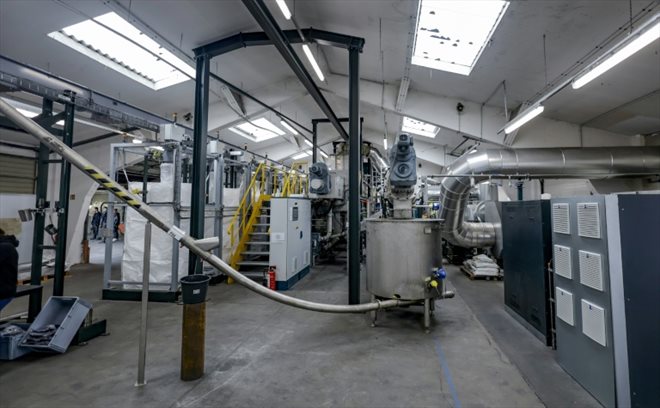An employee of the “Circular Carbon” company shows crushed cocoa shells on May 10, 2023 in Hamburg, Germany (AFP/Axel Heimken)
A new black gold? A stone’s throw from the port of Hamburg, a discreet red brick factory manufactures an astonishing dark powder, called biochar, with extraordinary properties to fight against global warming.
This vegetable charcoal, which she obtains by heating oxygen-deprived cocoa shells at high temperatures, has the capacity to trap greenhouse gases for centuries.
Sustainable fertilizer, biogas production, “green” concrete, this technology, whose industrialization is in its infancy, could become key for the ecological transition.
According to the IPCC, biochar would make it possible to store on a large scale 2.6 billion tonnes of CO2 each year, out of the 40 billion emitted by humanity. But its massification remains a challenge.
– Amazonia –
“We are reversing the carbon cycle,” Peik Stenlund, CEO of Circular Carbon, the German company with 40 employees that runs the Hamburg plant, one of the largest in Europe, told AFP.

Peik Stenlund, CEO of Circular Carbon, in front of transport bags for cocoa shells, on May 10, 2023 in Hamburg, Germany (AFP/Axel Heimken)
In a white silo, the installation receives, via a network of gray pipes, the cocoa shells, production waste from a neighboring factory, belonging to a multinational chocolate company.
These elements are heated to more than 600 degrees without oxygen, to prevent their combustion, according to a process called pyrolysis. The biochar comes out, in the form of black powder, trapping the CO2 of the cocoa.
Without this process, the carbon in these residues, unused by industry, would have evaporated into the atmosphere during their decomposition, thus contributing to global warming.
Now he is sequestered “for centuries”, explains to AFP David Houben, researcher at the UniLaSalle institute, in France.
One ton of biochar stores on average “the equivalent of 2.5/3 tons of CO2”, according to the scientist. Any vegetable can be used.
Biochar has long been used by pre-Columbian civilizations as a fertilizer. It was rediscovered in the twentieth century by scientists studying the “terra preta”, extremely fertile black soils in the Amazon.

Peik Stenlund, CEO of the company “Circular Carbon“ in the biochar production plant, on May 10, 2023 in Hamburg, Germany (AFP/Axel Heimken)
Its sponge-like structure improves agricultural yields, with better absorption of water and nutrients, decreasing the need for irrigation and fertilizers.
In Hamburg, a strong heat and a smell of chocolate emanates from the pipes of the factory.
The biochar is packaged in dozens of white bags, before being sold to farmers in the region.
Silvio Schmidt, 45, who takes care of a potato field near Bremen, is one of them. “We have very sandy soils. We hope that this will make it possible to produce quality humus to provide more nutrients and water to the soil,” he explains to AFP.
– Cost prohibitive –
Pyrolysis also releases biogas, itself resold to the neighboring plant. A total of 3,500 tons of biochar and “up to 20 mWh” of gas are produced each year in the plant, along with 10,000 tons of cocoa shells.
But this circular system will be complicated to apply on a large scale to achieve the objectives of the IPCC.

(AFP/Axel Heimken)
“To release less carbon than we store, everything must happen locally, with little or no transport. Otherwise it makes no sense,” explains David Houben.
It’s not always the case. The soils are not all receptive to biochar, “more effective in tropical climates”, and the raw material is “not available everywhere”, according to the researcher.
Above all, the cost of biochar is prohibitive, “around a thousand euros per tonne, too much for a farmer”, says David Houben.
The researcher believes that other uses, such as “construction”, should be encouraged. Biochar can be used in making “green” concrete.
To make the activity profitable, the sector relies on another source of growth: carbon credits.
The idea is to sell certificates to companies wishing to achieve carbon neutrality to offset their CO2 emissions.
With these resources, “we see strong growth in the industry in the future, with a multi-billion dollar market,” says Stenlund. The company plans to open three new factories in the coming months.
Throughout Europe, projects are multiplying. Annual production should increase from 53,000 to 90,000 tonnes between the end of 2022 and the end of 2023.
© 2023 AFP
Did you like this article ? Share it with your friends with the buttons below.




